How to make money on the visionOS App Store
It may not be the gold rush that the original App Store was, but now is the time for experimentation and innovation.
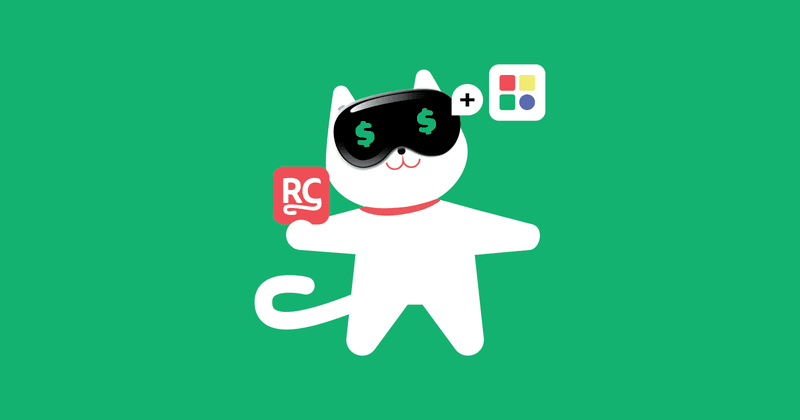
Last week I spoke at the first visionOS conference in Beijing, Let’s visionOS. When I was first contacted about it I thought it would be fun to explore what the best monetization methods are for visionOS apps right now.
After digging into the data, what I learned is… it’s going to be really hard!
When Apple first announced the Apple Vision Pro along with the visionOS App Store, there were a lot of people comparing it to Apple’s other major hardware platform launches like the iPhone or iPad. These devices were extraordinarily successful and developers who built software businesses for them were richly rewarded.
There were a few reasons why the App Store was such a success, such as ease of use because Apple already had customer credit card information, and a wealthier, tech-forward customer base (initially). But the biggest reason was the sheer quantity of users who bought iPhones. So I dug into the numbers to compare the Vision Pro launch to Apple’s other platforms to try to understand what the size of the opportunity for visionOS developers is right now.
Unit sales of Apple’s other new platforms
One important note before we get into the numbers. This comparison aims to gauge the market size for visionOS developers. I’m not making any assertions about the success or failure of the Vision Pro as a product for Apple. Just comparing raw sales numbers is not an appropriate way to determine the product’s success. But it is a good way to measure what your total addressable market is if you build a visionOS app.
Vision Pro
Apple hasn’t actually released numbers for the Vision Pro sales so we’ll have to work off of rumors. This isn’t ideal, but I think the general ballpark numbers will be close enough to illustrate my points. But definitely take these with a grain of salt.
Analyst Ming-Chi Kuo estimated that Apple sold 160,000 to 180,000 Vision Pro units during the first pre-order weekend. Later Kuo claimed sales were better than Apple originally expected, and Apple actually increased its production order to 700,000-800,000 units for the year. Usually production orders are higher than the actual finished units shipped, but let’s just take the higher number, 800,000, as the projected Vision Pro units Apple will ship in its first year.
iPhone
Now let’s compare to the original iPhone launch. According to Apple, the first iPhone sold 270,000 units in its first 30 hours and 1 million units in the first 74 days! Apple didn’t release official numbers for the first full year, but many sources I found claimed a little over 6 million original iPhones sold in its first year.
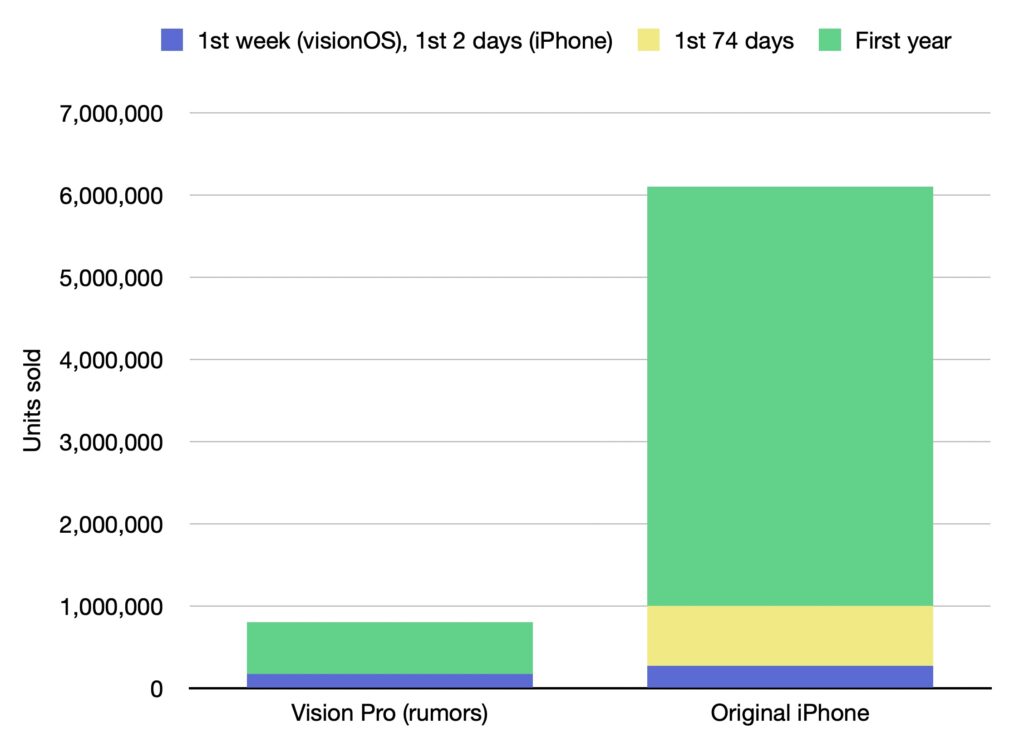
As you can see, this is a pretty staggering difference. And this chart isn’t actually telling the whole story. The original iPhone didn’t even launch with the App Store. That came a year later with the iPhone 3G. If we want to contextualize the visionOS as a market for 3rd party devs up against the original launch of the iPhone, we have to compare to iPhone 3G sales plus the original iPhone sales.
The iPhone 3G sold 1 million units in its opening weekend alone! Apple didn’t release 1 year numbers for the iPhone 3G, but Rene Ritchie at iMore estimated it was about 20 million. To measure the market size of iPhone users for the first year of the App Store, you would add these iPhone 3G sales with the sales of the original iPhone.
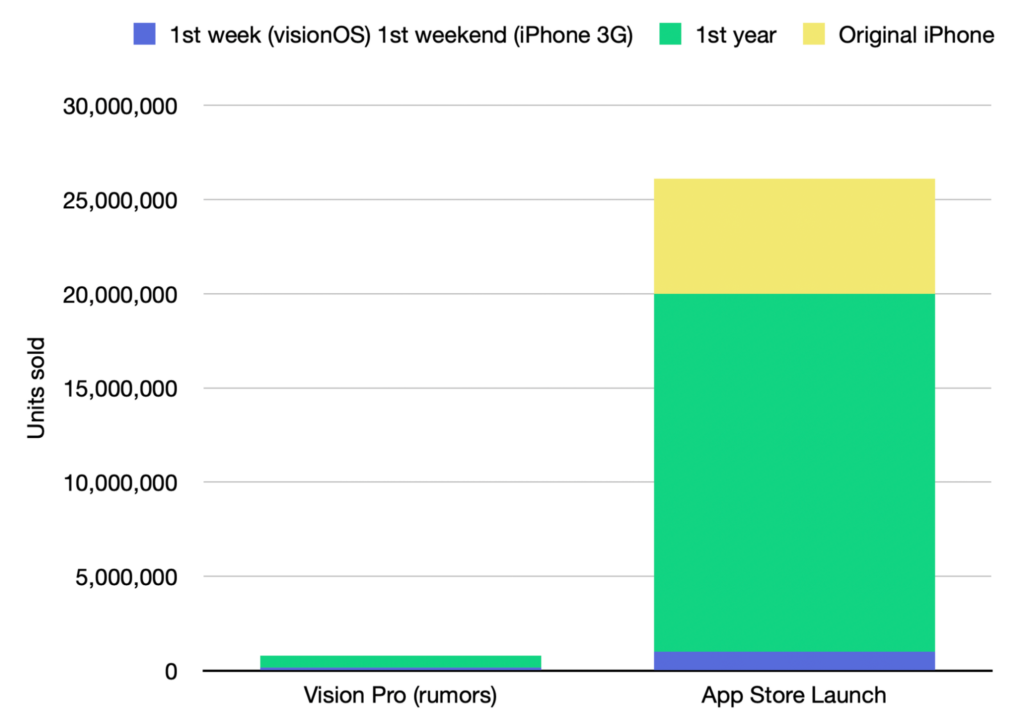
This is the context for beer drinking simulators and fart apps making tens of thousands of dollars a day during the early days of the App Store. There were so many customers with iPhones that even a small percentage of them could make for a large user base for your app.
There was also a difference in competition. When the App Store first launched, there were 500 apps available. With the visionOS App Store, it was actually pretty similar with 600 native apps at launch. However, on the visionOS App Store, you can also download iPad compatible apps, which Apple happily promotes inside of the App Store alongside native visionOS apps. According to Apple, there are over 1 million iPad compatible apps at launch. This means your apps are competing with way more other apps in the store for customer attention.
iPad and Apple Watch
Ok, so comparing the visionOS App Store opportunity to the original iPhone App Store isn’t fair. What about Apple’s other marketplaces they’ve launched since then?
The iPad sold 300,000 units on its first day alone and 15 million units in its first year. The Apple Watch, despite many claiming a failed launch, had 957,000 preorders and went on to sell over 11 million units.
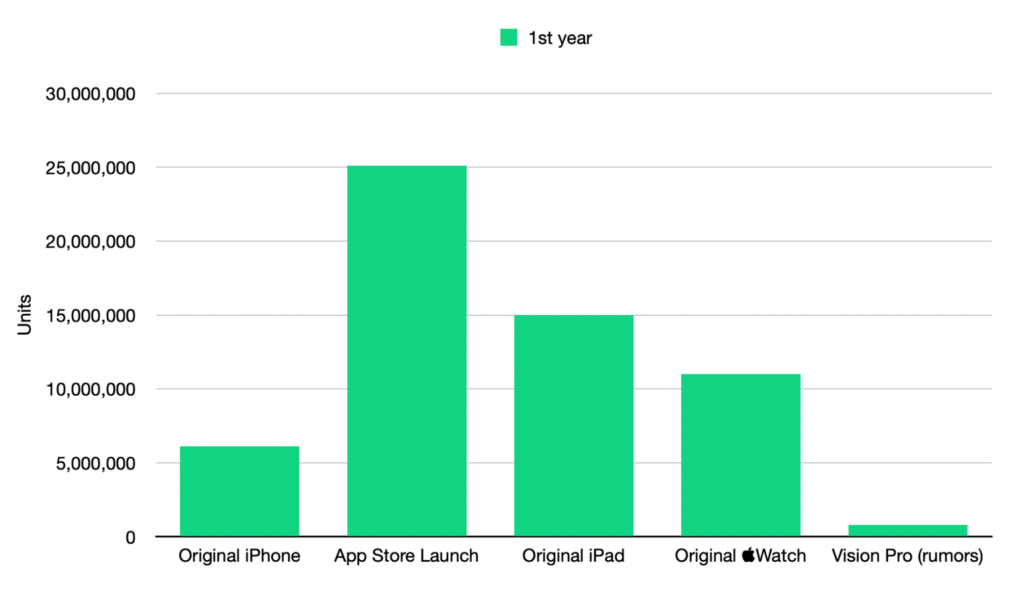
Conversion rates are great
Now just because the visionOS market is small doesn’t mean there isn’t any money to be made. You just need to make sure you’re setting your expectations clearly up-front.
Interestingly, my apps show visionOS’s conversion rates surpassing other platforms.
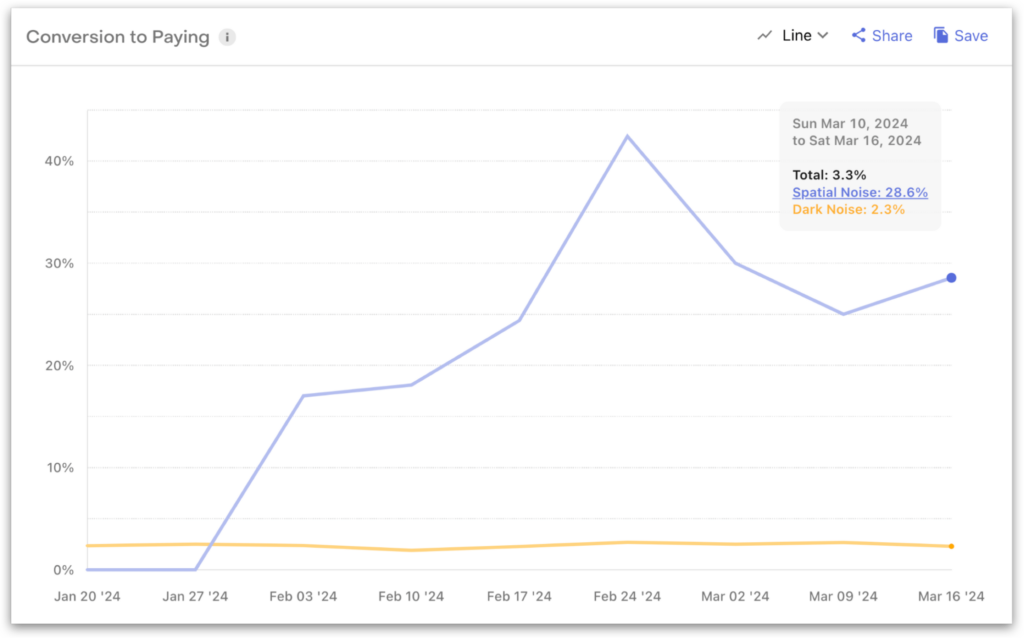
I’ve talked with quite a few other visionOS developers and they see the same trend. Some developers have even reported that their iPad compatible apps are also seeing much higher conversion rates on visionOS than on other Apple platforms.
This is mostly likely explained by natural segmentation of the market. Users who’ve bought an Apple Vision Pro are much less likely to be price sensitive. They’re also, by definition, early adopters who are probably actively looking for fresh software experiences and are willing to pay for them.
This post on Threads from Benedict Evans articulates this type of user well:
“I’ve certainly bought stuff on Vision Pro that I would never have bought on my iPhone just because I want to know what it is. $10/games I deleted after 30 seconds etc.”
If your goal is to make money with a visionOS app today, I think you have to keep this type of user in mind.
How to monetize a visionOS app
Developers have the same options for monetizing their visionOS apps as they do on iOS.
- Free (with ads)
- Paid up-front
- In-app purchase
- Subscription
Let’s go through each option and explore how effective it might be in the context of visionOS.
Free (with ads)
If you’re trying to monetize a free app in the app store, the most common approach is to use a 3rd party ad SDK to serve some kind of banner ads to your users.
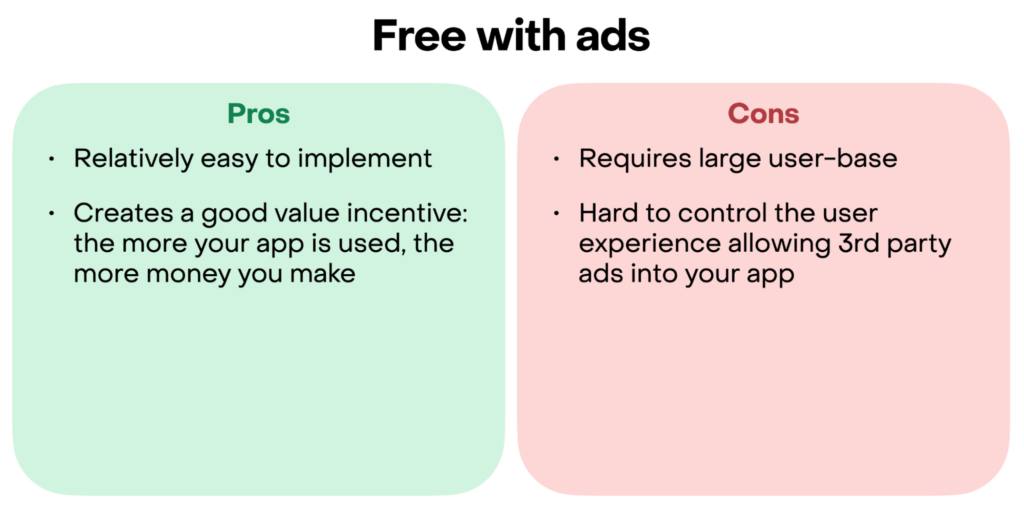
Pros
- Relatively easy to implement
- Creates a good value incentive: the more your app is used, the more money you make
Cons
- Requires a large user base
- Hard to control the user experience when allowing 3rd party ads into your app
For the most part, ad SDKs are actually relatively easy to implement into your app. There are multiple ad SDKs such as Google’s AdMob or Facebook Ads and generally they do a pretty good job of making it easy for developers to integrate them into their apps.
Ad monetization also creates a good incentive for developers. Apps make money based on how often users engage with their app. So apps that provide frequent value to users are rewarded more than apps that trick users into downloading but don’t deliver in the long run.
The problem, however is that ads in visionOS apps need many frequent users. As we established before, visionOS as an entire platform has a much smaller user base than we’re used to from some of Apple’s other platforms. And the Vision Pro is cumbersome, which may lead to less daily use compared to the iPhone.
Ad frameworks also usually come with a negative impact on your app’s user experience. You don’t have full control of what ads your user’s are exposed to. Often you can turn off certain, less desirable, ad categories such as gambling, but your income will also take a hit as those ad categories are often the most profitable.
Who should choose free (with ads)?
- Apps that have or need a large user base
- Apps with high frequency engagement for each user
Paid up-front
Paid up-front apps are apps that require a payment to download from the App Store.
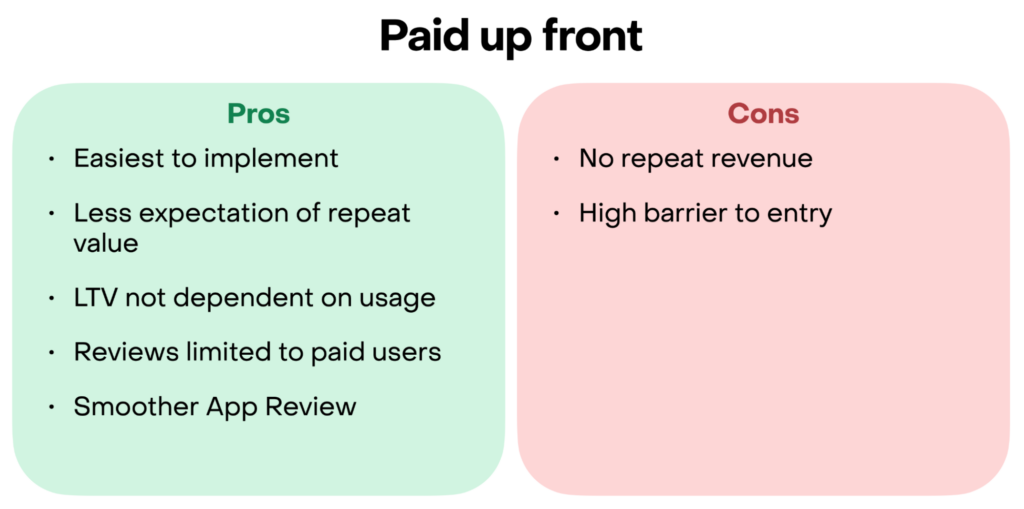
Pros
- Easiest to implement
- Less expectation of repeat value
- Lifetime Value is not dependent on usage
Cons
- No repeat revenue
- High barrier to entry for users
Paid up-front apps are by far the easiest to implement. You simply build your app with no monetization method at all and then select a price in App Store Connect when you release it.
As a result of it being a single payment, there is also less of an expectation of repeat value for customers. If a user pays for the app, uses it once, and moves on they are still getting the value they paid for. This also means developers get the full lifetime value of each customer immediately. This means apps are not financially punished if users churn after a few uses.
The big negative to paid up-front apps is that there is no repeat revenue. Users that continue to use your app for years and years will not pay you anything for the updates you release over that period of time. This makes it difficult for developers to continue investing in a single app instead of building out brand new, less full featured apps.
This is even more problematic for apps with repeated per-user costs such as weather apps or AI apps that have API costs that scale up with the number of users they have. Over time a paid up-front app may cost the developer more money in per-user costs for their past customers than they are making in sales from new customers.
Paid up-front apps also have a higher barrier of entry for downloads from the App Store because there is no free tier. This can be an issue if you are trying to grow a large user base for social features or if you are simply trying to learn more from customer feedback.
Who should choose paid up-front?
- Hobby apps
- Assuming you do not have recurring per-user costs
- One time experiences vs apps with ongoing value
- Developers who want to recoup their investment quickly
Paid up-front is a great monetization method for hobby apps. It’s easy to implement, and allows you to release your app to the world more quickly. It’s also great for apps offering a one time experience. For Vision Pro, these are the types of apps people are happy to pay for, especially if it offers something unique to the platform.
By charging up-front, you will be able to recoup your investment quicker. However, it’s less likely you’ll build a sustainable business off of the app through recurring revenue.
In-app purchases
In-app purchases allow you to offer your app for free to download but charge to unlock features within the app itself. There are two types of in-app purchases: consumable in-app purchases and one-time in-app purchases.
Consumable in-app purchases are products that can be used up in the app and then purchased multiple times by the user. Most often this is used for games. One-time in-app purchases are products that can be purchased once, and unlock a feature for that user forever. We’re going to focus on one-time in-app purchases here.
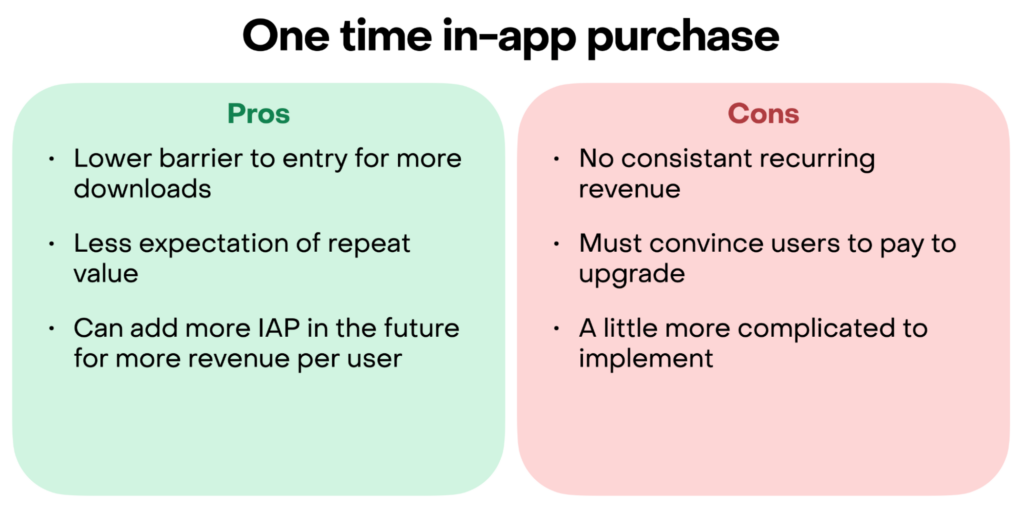
Pros
- Free tier offers lower barrier of entry for more downloads
- Less expectation of repeat value
- Can add more in-app purchases in the future for more revenue per user
Cons
- No consistent recurring revenue
- Must convince users to pay to upgrade
- A little more complicated to implement
The big advantage in-app purchases have over paid up-front apps is a lower barrier to entry. Users can download the app for free and make the decision on whether the app is worth paying for after seeing an onboarding flow or experiencing a free tier of your app instead of having to make that choice just by looking at your App Store screenshots and description. This makes in-app purchases a great choice if you’re trying to grow your user base for the sake of getting more feedback as you’re learning more about developing for visionOS.
In-app purchases also afford the same advantage as paid up-front apps with regards to less expectation of repeat value. Users who pay a single time to unlock features have less of an expectation of continued investment and new features than they would if they had a recurring cost.
Another advantage is that you can add new in-app purchases to your app in the future to monetize your existing users. For example, you may offer new “packs” of content periodically that users have to pay for separately.
Despite this, in-app purchases still don’t offer consistent recurring revenue. This approach makes it difficult to sustain apps with recurring per-user costs over years, as the user base grows.
You also have to be careful with what features to make free and what features to put behind the paywall. For visionOS in particular, users are often only looking for the novel experience in your app and may never return again. If your free tier offers the full novel innovation of your app, most users may just stick with the free tier and never pay.
And finally, in-app purchases are a little more complicated to implement than paid up-front. Using the RevenueCat SDK, this is much much easier, but there is still some configuration and coding to be done.
Who should choose in-app purchases?
- Hobby apps
- Assuming you do not have recurring per-user costs
- One time experiences vs apps with ongoing value
- Apps with packs of content or experiences to unlock
In-app purchases are a good choice for the exact same apps as paid up-front. I think the big differentiator is that in-app purchases are a little bit more work up-front to set up, but will increase your user base which will make it easier to learn and iterate on user feedback. You’ll also have more flexibility to add new in-app purchases in the future and monetize your existing user base.
Subscriptions
Subscriptions are the bread and butter of mobile app businesses. These are usually free to download, and offer one or more subscription products to unlock more features within the app. But do subscriptions make as much sense right now for visionOS apps as they do on iOS?
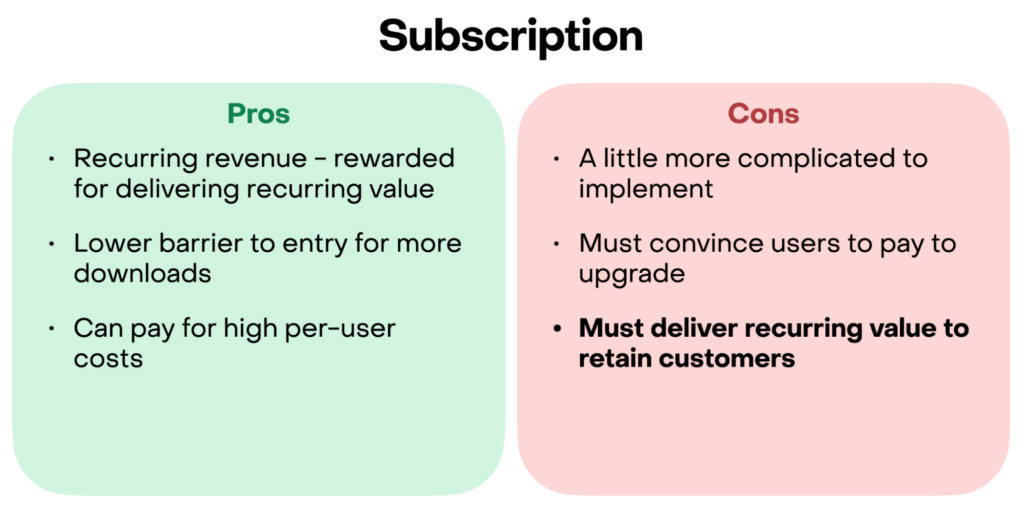
Pros
- Recurring revenue – apps are rewarded for delivering recurring value
- Free tier offers lower barrier to entry for more downloads
- Recurring revenue can pay for high per-user costs
Cons
- A little more complicated to implement
- Must convince users to pay to upgrade
- Must deliver recurring value to retain customers and increase lifetime value
Subscriptions offer a great incentive for developers. Apps that deliver recurring value to their users are rewarded with recurring revenue. This recurring revenue also makes it possible to run an app with higher per-user costs like weather apps or AI apps that have to pay API fees.
Subscriptions also have a much lower barrier of entry. You can offer a free tier, free trials, and even cheaper subscription durations like monthly or weekly to let more users experience your app.
Subscriptions are definitely the most complicated monetization model to implement though. RevenueCat makes this dramatically simpler, but it’s still more complicated than paid up-front, or even in-app purchases to set up and maintain over time.
Just like in-app purchases, you’ll need to be careful where you draw the line for which features should be included in your free tier. If you’re giving away the core experience in the free tier, it may be harder to convince users to upgrade.
I think the biggest issue with subscriptions on visionOS is that users must see recurring value in order to subscribe and retain over time. I suspect when most visionOS users look at a subscription, they don’t even know if they’re going to use this device regularly at all, which will reflect on their perceived recurring value of your app. It’s a harder sell than asking for a single payment up-front in order to get an one-off experience.
Who should choose subscriptions?
- Apps with high per-user costs
- iOS or macOS apps that want to add visionOS support as a feature of their existing subscription app
I think subscription apps are going to have a harder time in the early days of the visionOS App Store than apps with one-time purchases. If your app has high per-user costs though, it’s still probably the safest option.
I do think visionOS support represents a good feature to add to iOS or macOS apps with existing subscription products however. In this case, a subscription would unlock features across all platforms, including visionOS. I think this is a great way to market your existing app and signal your app’s commitment to being a strong platform citizen.
What is everyone else doing?
I reached out to my friend Ariel from Appfigures to get a sense of how other developers are monetizing their apps on the visionOS App Store. He’s been tracking visionOS development since it’s release in February and he kindly gave me some data.

If we look at all native visionOS apps, the breakdown is roughly 1/3 free, 1/3 paid up front, and 1/3 some combination of subscriptions and in-app purchases. This is still a higher percentage of paid up front than you would see in the App Store on iOS, but given the higher percentage of indie apps on visionOS vs large companies at launch, that’s not entirely surprising.
The really surprising numbers to me are when we filter down to apps that are only on visionOS, meaning they are not cross-platform apps available on iOS or macOS already. Here we find nearly half are paid up front apps, 40% are free, and only about 13% are some combination of in-app purchases or paid up front.
For more information on visionOS developer trends over time I highly recommend following Ariel on the Appfigures blog.
My recommendation
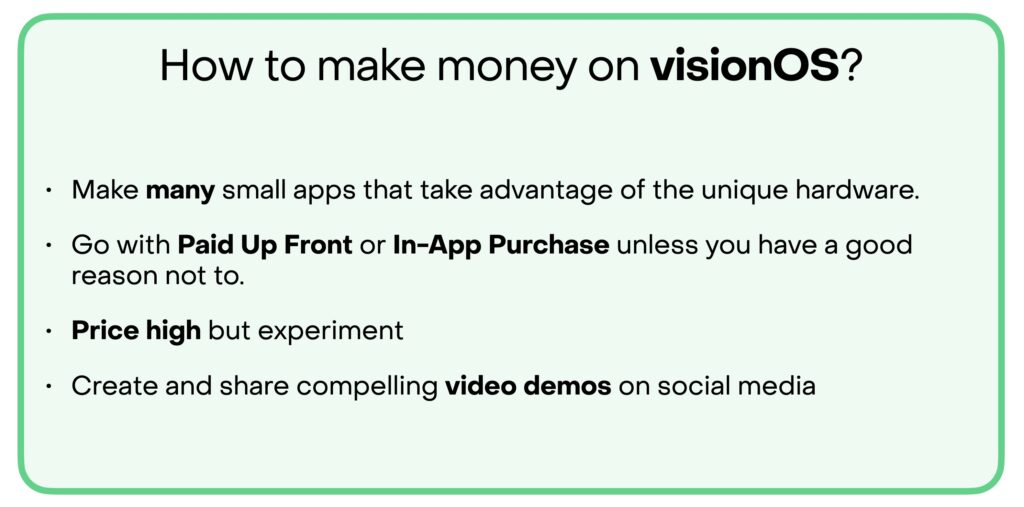
If you’re building a visionOS app today and want to optimize for making money, here is my recommendation. I would start by making many small apps that somehow take advantage of the unique hardware of Apple Vision Pro. People are looking for unique experiences right now, so that’s where you should focus your effort.
For the business model, I would go with paid up-front or one-time in-app purchases unless you have a particularly good reason not to. I almost think of it more like you’re selling a movie-like experience vs. a traditional, long-term app business where a subscription business model might make more sense. Paid up-front is the easiest to implement, but a free tier with an in-app purchase will allow you to gain more users and get more feedback quickly if you’re trying to learn more about the platform.
For pricing, I would start out high but experiment with different prices. Initial Vision Pro users are not going to be very price sensitive, but this might change over time. Using RevenueCat experiments is a good way to run a simple A/B if you’re using in-app purchases so that would be a good place to start.
The visionOS App Store isn’t nearly as competitive as iOS, but it can still be hard to bring awareness to your app unless you’re lucky and get featured by Apple. For this I would heavily focus on sharing compelling video demos on social media. Vision Pro content is still popular, even among people who do not own the device, so video content that showcases how it feels to use your unique experience is a good way to attract attention for your app.
Ultimately, the visionOS App Store is not the gold rush for 3rd party developers like the original App Store was. We’re at the forefront of a new and exciting technological platform from Apple. Now is the time for experimentation and innovation. But there’s still some money to be made! Hopefully this guide helps make that a little bit easier.
You might also like
- Blog post
The complete guide to SKAdNetwork for subscription apps
Understanding Apple's privacy-first attribution
- Blog post
“A big market is great only if you can take a substantial share of it” — Patrick Falzon, The App Shop
On the podcast: estimating the revenue potential of an app, crafting an exit strategy, and why LTV is such a terrible metric.
- Blog post
Effective testing strategies for low-traffic apps
Is A/B testing off the table? Let’s rethink experimentation.

